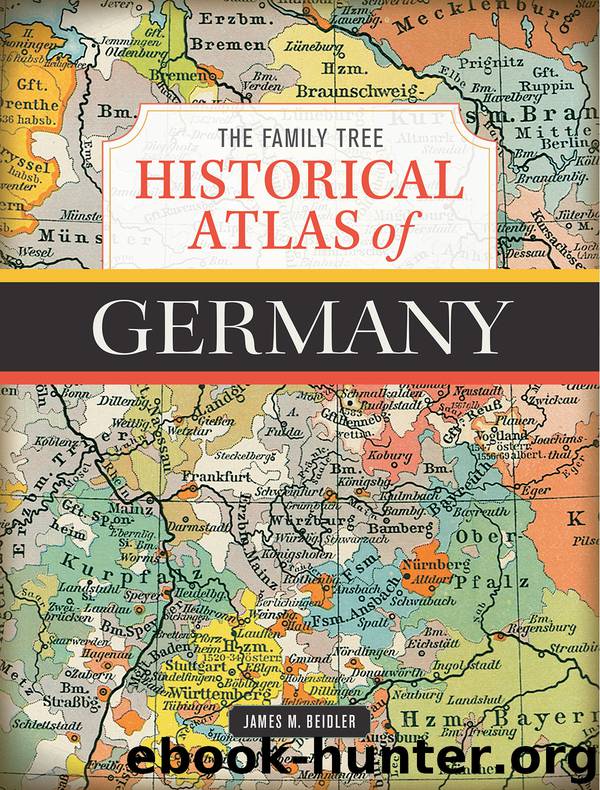The Family Tree Historical Atlas of Germany by James M. Beidler

Author:James M. Beidler [Beidler, James M.]
Language: eng
Format: epub
Publisher: Penguin Publishing Group
PART FOUR
Nineteenth-Century Germany
German states in the nineteenth century—a time typically spanning from Napoleon’s final defeat in 1815 through the end of World War I in 1918—went through relatively few boundary changes compared to earlier centuries. But the unchanging borders belied immense political, economic, and social changes happening within the states and among their residents.
The era began with the Congress of Vienna, which was designed to put Europe on an even keel after two decades of Napoleonic turmoil. And while the Congress used the principle of “legitimacy” to restore many parts of Europe to their previous rulers, it didn’t completely turn back the clock for the German states. Some of the German states were returned to their pre-1789 overlords, but the Congress mostly maintained Napoleon’s consolidation of small states into larger units. Prussia became more of a force in western Germany, gaining the Rhineland and Westphalia. Poland, which Napoleon had partially resurrected under the name “Grand Duchy of Warsaw,” was again partitioned out of existence, but with slightly different allocations to Prussia, Russia, and Austria.
The Congress also created the Germanic Confederation, a faint echo of the old Holy Roman Empire (which remained dead). The now mostly larger German states embraced capitalism—or, at least, no longer operated under feudal rules that discouraged it. And though they failed, the Revolutions of 1848 awoke in some people a political consciousness, spurring some to emigrate to America and others to advocate for political reforms.
After the Napoleonic Wars, emigration from the German states began again in earnest. Industrialization in Germany meant the labor force required fewer agricultural workers and created many urban factory jobs. This labor market change (along with the low quality of life that often accompanied them) was a major “push factor” that spurred immigration to America, as were restrictive marriage policies and the institution of military service requirements by many of the German states. “Pulling” immigrants to America were the many existing German-speaking enclaves, along with the economic and political freedom that could be found there.
Prussia continued its march to dominance. Under its “blood and iron” chancellor Otto von Bismarck, Prussia pursued a dual strategy of uniting the disparate parts of its own kingdom (through military force against other German states) and making Prussia the leader of a united German empire (through a combination of economic pressure and military success against outside rivals). Prussia first fought with Austria in 1864 to “liberate” Schleswig and Holstein from Danish control, one of several short wars that resulted in some of the only boundary changes in the nineteenth century.
When Austria realized that those territories would be added to Prussia rather than remain independent German states in 1866, it declared war and lost quickly and spectacularly in what has become known as the Seven Weeks’ War. Austria could no longer contest Prussia’s leadership of the German states, and Prussia punished the German states that sided with Austria: Hanover, Hesse-Kassel, Nassau, and the free city of Frankfurt all lost their independence, while Hesse Darmstadt ceded territory to Prussia.
Prussia
Download
This site does not store any files on its server. We only index and link to content provided by other sites. Please contact the content providers to delete copyright contents if any and email us, we'll remove relevant links or contents immediately.
Twilight of the Idols With the Antichrist and Ecce Homo by Friedrich Nietzsche(17707)
CHERUB: The Recruit by Robert Muchamore(1828)
CHERUB: The Fall by Robert Muchamore(1712)
CHERUB: Man vs Beast by Robert Muchamore(1611)
I Capture the Castle by Dodie Smith(1573)
The Edge of the Abyss (Sequel to The Abyss Surrounds Us)(1468)
Black Genesis by Robert Bauval(1319)
A Brief History of Everyone Who Ever Lived by Adam Rutherford(1249)
all by Unknown Author(1242)
Where Do I Start? by Chase Taylor Hackett(1060)
2016 Baby Names Almanac(978)
Painfully Rich by John Pearson(958)
Genetics by Adam Rutherford(921)
How to Argue With a Racist by Adam Rutherford(881)
2011 Baby Names Almanac(842)
Black Hawk Down by Mark Bowden(829)
It's All Relative by A. J. Jacobs(798)
My European Family by Karin Bojs(786)
Spook Street (Slough House) by Mick Herron(780)
